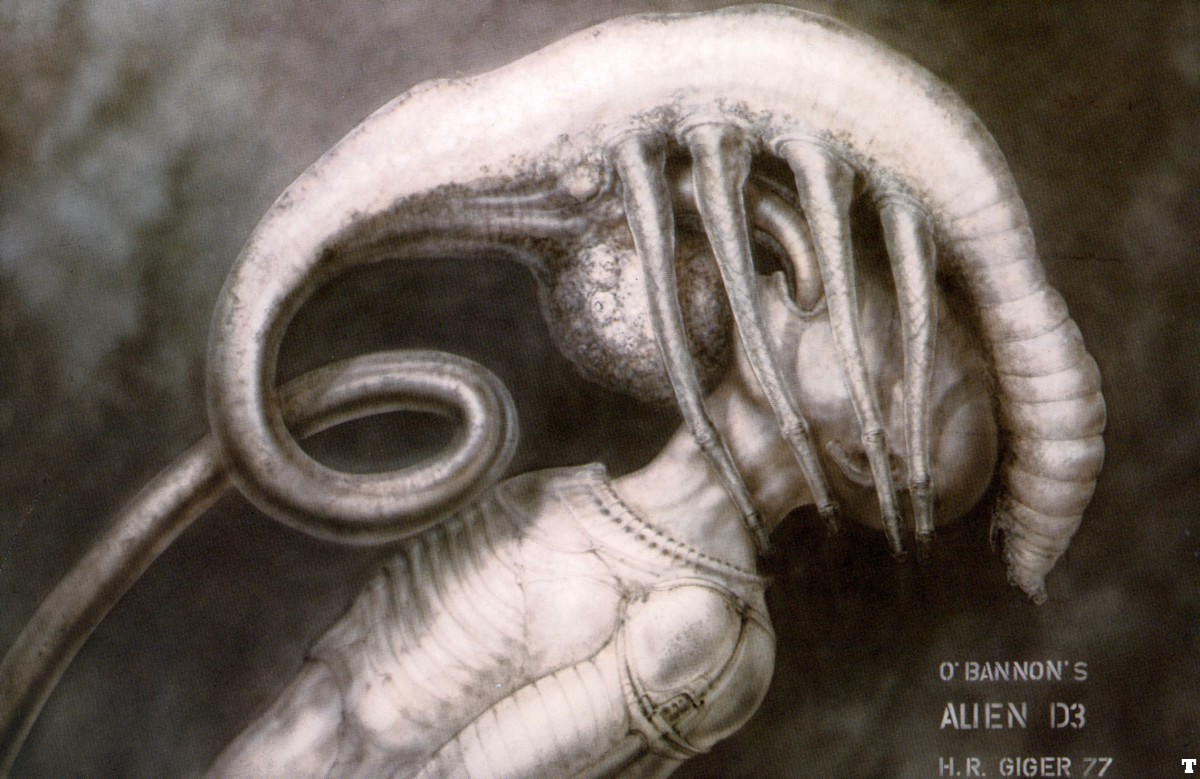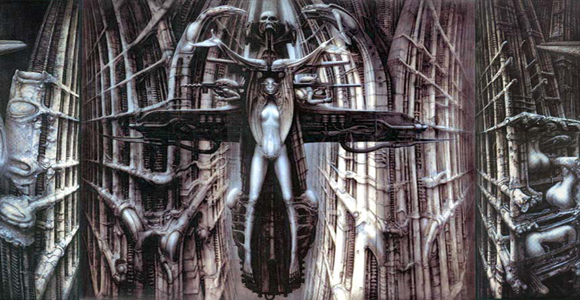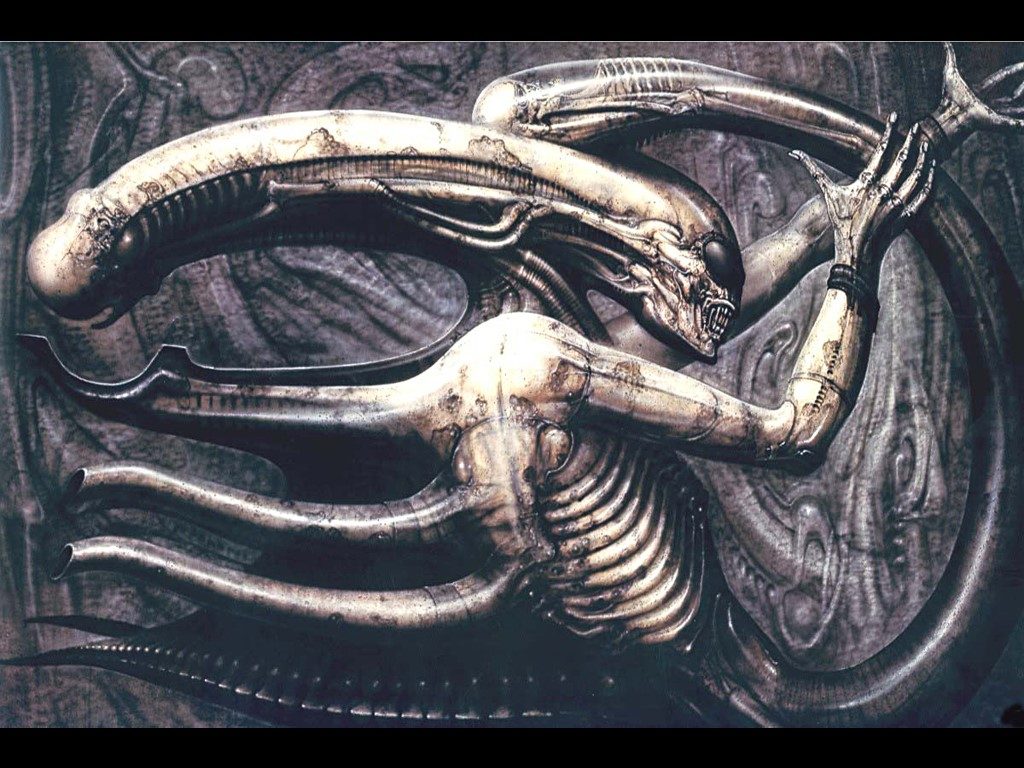
 When the topic of Ridley Scott’s Alien is brought up it’s not uncommon to hear the term iconic thrown around. The Xenomorph has become a legendary movie monster that ranks among the modern cinematic pantheon with the likes of creatures like Pumpkinhead or its frequent nemesis the Predator. However, when you compare it to all of its other peers the xenomorph is a monster that truly stands alone in the way it manages to both terrify and captivate the viewer. It’s beautiful and terrifying, two words that aptly describe the body of work of its mastermind, H.R. Giger. Giger was a painter first and foremost. Although he was sought after by Ridley Scott his career was not primarily in film, which was perhaps why his work stood apart so starkly in comparison to other designers and art directors in the horror genre. Rather than standing on the shoulders of giants like Stan Winston did with Harryhausen (As an aside, Stan Winston did brilliant work in the subsequent Aliens). Giger was an outsider who approached his design with influences he drew from his surrealist art background
When the topic of Ridley Scott’s Alien is brought up it’s not uncommon to hear the term iconic thrown around. The Xenomorph has become a legendary movie monster that ranks among the modern cinematic pantheon with the likes of creatures like Pumpkinhead or its frequent nemesis the Predator. However, when you compare it to all of its other peers the xenomorph is a monster that truly stands alone in the way it manages to both terrify and captivate the viewer. It’s beautiful and terrifying, two words that aptly describe the body of work of its mastermind, H.R. Giger. Giger was a painter first and foremost. Although he was sought after by Ridley Scott his career was not primarily in film, which was perhaps why his work stood apart so starkly in comparison to other designers and art directors in the horror genre. Rather than standing on the shoulders of giants like Stan Winston did with Harryhausen (As an aside, Stan Winston did brilliant work in the subsequent Aliens). Giger was an outsider who approached his design with influences he drew from his surrealist art background
So what exactly makes Giger’s designs stand out?

When you look at the art design throughout Alien there is just something genuinely unsettling about it. Whether it be the nightmarish facehugger, or the enigmatic Space Jockey, or the Xenomorph itself, it all feels both organic and unnatural. That is what I believe makes his designs resonate so deeply, Giger’s signature ‘biomechanical’ aesthetic creates a sense of unease. Part of the reason for this uneasiness in the viewer is because it’s such a shocking juxtaposition. Giger often uses sensual or even sexual elements in his work and blends them seamlessly with the grotesque and unnatural. The sense of uncertainty a viewer has reacting to seeing these images is part of what makes them so compelling, you’re made to feel like the things you’re seeing simply should not exist.
He didn’t just make a monster, he made a haunted house.

Beyond the titular monster, part of what made Alien so memorable was in its setting. From the start you’re put off by the barren planetoid the crew of the Nostromo happens upon, where we first see the mysterious derelict ship. This is what sets this film apart from Ridley Scott’s sci fi aesthetic he became known for. While the Nostromo is a showcase of the grungy industrial utilitarian sci-fi design that would later become the lifeblood of the world Scott created in Blade Runner, the derelict craft is Giger all over. The spacecraft is comprised of almost gothic arched corridors featuring intricate tubes lining the walls. The doors and archways are unmistakably sexual with the entire atmosphere making it feel like the crew investigating are actually navigating the corpse of some giant ancient beast. That concept is never more true than when they enter the ship’s hatchery where poor Kane is met with what will ultimately turn out to be one of the most unpleasant deaths in cinematic history. Coupled with Scott’s strong direction the design of the ship itself sets up a crucial component of what makes the film resonate. Its themes. While being well trodden territory there really is no way to avoid it, Alien is a movie about sexual violence, at points quite literally so. So when we consider the nature of the story and the events that unfold it begs the question, how effective would it have been without H.R. Giger? Ridley Scott himself hand-picked Giger after looking at his book Necronomicon and was struck by the powerful sexualized imagery. H.R. Giger spent his artistic career exploring the complex and conflicted relationship human beings have with sexuality. Living in the age of a sexual revolution Giger grappled with the nature of sexuality in a way that was truly unique. Scott recognized this, and understood that Giger was instrumental in tapping into the most primal and terrifying aspects of sexual imagery.
Alright, let’s just get it out in the open and say it… Space Dicks.

You just can’t talk about the artistic direction of Alien without pointing out that it’s lousy with phallic imagery. From the Xenomorphs elongated head and it’s retracting mini mouth of terror to the Space Jockey looking like he died trying to turn his penis into a howitzer it’s just everywhere you look. While it’s obviously intentional the better question is what makes this imagery so effective, and what sets it apart from the likes of so many other horror metaphors alluding to the dangers of sexual promiscuity? Going back to poor old Kane two of the most shocking scenes in the movie come from his ill-fated encounter with the facehugger. Seeing a man getting impregnated by a rapey spider monster is enough to have just about anyone feeling squirmy. The reason it does this is because it evokes several taboo subjects simultaneously. Male on male rape, impregnation from rape, and bestiality are all topics that are considered by many to be distasteful topics to broach. H.R. Giger has explored taboo subject matter thoughout his art and in his design of the facehugger manages to pack so much uncomfortable subject matter into one tiny nightmarish package. H.R. Giger’s artistic sensibilities inform these challenging of taboos throughout, the sexualized design of the ship and the Xenomorph force the taboo nature of looking directly at imagery evoking genitalia and presents it without comment. That in itself does volumes for creating tension in the audience.
It’s no secret that H.R. Giger was a key component to Ridley Scott’s successful realization of his vision in Alien. It’s well established that we owe the frightening design of the family of horrible creatures in the film to his twisted and beautiful vision. However what is important to recognize is that not only did he create an iconic movie monster, Giger created an atmosphere and tension that was essential for Scott to realize his vision for the film. Without the phallic abominations and complex sexualized gothic imagery Scott would not have been able to create the sense of dread and discomfort that made Alien the film that it was.



